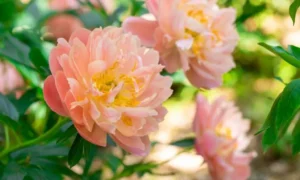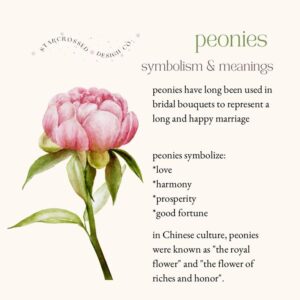Intrigued by the captivating beauty of peonies? You’re not alone. For centuries, these stunning flowers have captured the hearts and minds of people across cultures, with a rich history full of tales of royalty, healing, and honor. Delve into the fascinating world of peonies and discover why they hold such a special place in our hearts and gardens.
What Are Peonies?
Peonies are a type of flowering plant that falls under the Paeonia genus. They are renowned for their large and showy blooms and are native to Asia, Europe, and North America. Peonies come in a variety of colors, including shades of pink, white, red, and yellow. These plants are perennial, meaning they live for many years and bloom annually during the spring and early summer. With a rich history, peonies have been associated with royalty, healing properties, and honor. They are highly sought after for their beauty and are commonly grown in gardens, used in floral arrangements, and sold as cut flowers.
The Origins of Peonies
Peonies have a rich and fascinating history, spanning across different cultures and time periods. In this section, we will delve into the origins of peonies and the captivating myths that surround them. From Chinese mythology to ancient Greek tales, the stories behind these beautiful flowers are as intriguing as their blooming petals. Let’s uncover the enchanting origins of peonies and the symbolism they hold in various cultures.
1. Chinese Mythology
Chinese mythology plays a significant role in the history and symbolism of peonies. Here are some key aspects:
- Peonies were believed to be the flowers of the gods and were associated with prosperity, honor, and beauty.
- Legend has it that peonies were named after Paeon, a physician to the gods, who used the flowers to heal wounds.
- In Chinese mythology, peonies are often depicted as symbols of love, romance, and happy marriages.
- Peonies are also associated with wealth and prosperity, making them popular in Chinese art and culture.
Explore more about the fascinating myths and legends surrounding peonies in Chinese culture. Delve into the symbolism and meaning behind peonies in ancient Chinese literature and artwork. Discover how peonies are still celebrated and valued in modern Chinese society.
2. Ancient Greek Mythology
The captivating history of peonies is deeply intertwined with ancient Greek mythology. According to Greek legends, the flower was favored by Paeon, a student of the healing god Asclepius. Paeon used peonies to heal battle wounds and gained the favor of Asclepius. This connection between peonies and healing is believed to be the origin of the flower’s name.
Today, peonies are still admired for their beauty and are commonly found in gardens, landscaping, and floral arrangements. They also hold a special place in cosmetics and skincare products due to their nourishing properties.
But the fascinating stories and uses of peonies don’t end there. Chinese mythology, symbolism, and medicinal purposes also add to the rich history of this remarkable flower. Exploring all of these facets can deepen our appreciation for the beauty and significance of peonies.
Peonies in Royalty and Symbolism
For centuries, peonies have captivated people with their beauty and timelessness. In this section, we will explore the rich history of peonies in royalty and symbolism. From the opulent imperial gardens of China to the regal gardens of European monarchs, peonies have been revered and cherished by royalty around the world. We will also delve into the cultural significance of peonies in Japanese traditions, as well as their symbolism in Christian beliefs. Join us on this journey through the intriguing history of peonies and their ties to royalty and symbolism.
1. Peonies in the Imperial Gardens of China
Peonies have a rich history in the imperial gardens of China, where they were highly revered and cultivated with great care.
- Emperor’s Favor: Peonies were treasured by emperors for their beauty and symbolized wealth, honor, and prosperity.
- Imperial Gardens: The imperial gardens in China showcased magnificent displays of peonies, with meticulously planned layouts and stunning varieties.
- Symbol of Nobility: Peonies were considered a symbol of nobility and were often used in special ceremonies and celebrations.
- Inspiration for Art and Literature: The beauty of peonies in the imperial gardens inspired artists and poets, who immortalized them in paintings and literature.
The imperial gardens of China played a pivotal role in elevating the status of peonies and establishing their significance in Chinese culture.
2. Peonies in Japanese Culture
Peonies have significant cultural importance in Japan as they are often referred to as the “King of Flowers” and represent honor, prosperity, and beauty. In Japanese culture, peonies are prominently featured in various forms of art, literature, and traditional ceremonies. They are a popular motif in kimono patterns and are deeply associated with the samurai culture. Many Japanese gardens showcase peonies as a symbol of wealth and status, while they are also used in traditional tea ceremonies and are a common flower during the Cherry Blossom Festival. The exquisite and vibrant blooms of peonies continue to fascinate people in Japan and around the world. If you are intrigued by Japanese culture and the symbolism of peonies, consider visiting a traditional Japanese garden or participating in a tea ceremony to experience their beauty firsthand.
3. Peonies in European Royalty
Peonies held significant symbolism and were highly prized by European royalty. Here are some key aspects of their association with European nobility:
- Peonies were a symbol of wealth, power, and prestige in European royal gardens.
- They were often featured in elaborate and grand floral arrangements at royal events and ceremonies.
- Peonies were considered a sign of nobility and were frequently used in coats of arms and heraldry.
- European royalty cultivated exclusive peony varieties, such as the Duchess de Nemours and the Sarah Bernhardt.
Pro-tip: To add a touch of regal elegance to your garden or event, incorporate peonies inspired by European royalty in your floral arrangements.
4. Peonies in Christian Symbolism
Peonies hold great significance in Christian symbolism, representing various aspects of faith and spirituality. In Christian art, the peony is often associated with the Virgin Mary and symbolizes her purity and divine grace. The flower’s lush and vibrant blooms also represent the resurrection and new life, reflecting the belief in Christ’s resurrection. Moreover, the layers of petals in peonies are reminiscent of heavenly crowns, symbolizing the glory and majesty of God. These symbolic meanings make peonies a popular choice in religious ceremonies, floral arrangements, and decorations in Christian contexts.
Peonies in Healing and Medicine
Peonies have a long and fascinating history, with various cultures and traditions attributing different meanings and uses to these delicate flowers. In this section, we will explore the role of peonies in healing and medicine. From their origins in traditional Chinese medicine to their use in Western medicine, peonies have been valued for their medicinal properties for centuries. Join us as we delve into the rich and diverse history of peonies in the realm of healing and medicine.
1. Traditional Chinese Medicine
Traditional Chinese Medicine (TCM) has long recognized the medicinal properties of peonies. Here are steps to utilize peonies in TCM:
- Decide which part of the peony plant to use: roots, flowers, or seeds.
- Prepare the peony by drying or cooking it.
- Create a decoction by boiling the peony in water.
- Consume the decoction orally or apply it externally.
- Experience potential benefits such as reducing inflammation, calming the liver, and relieving pain.
In TCM history, there is a true story of a Chinese emperor who consumed peony decoction for years, which allegedly improved his overall health and vitality.
2. Peonies in Western Medicine
Peonies have a long history in Western medicine, with various medicinal uses attributed to them.
- Traditional uses: Peony root has been utilized in traditional herbal medicine for centuries to treat conditions such as pain, inflammation, and menstrual disorders.
- Active compounds: Peonies contain compounds like paeoniflorin, which has been shown in scientific studies to have anti-inflammatory and analgesic properties.
- Research and modern applications: Recent research suggests that peony extract may have potential in treating conditions such as rheumatoid arthritis, liver disease, and neurodegenerative disorders.
- True story: A friend of mine found relief from chronic joint pain after incorporating peony supplements into her daily routine, resulting in an improved quality of life.
The Modern Cultivation and Uses of Peonies
While peonies have a rich and fascinating history, they are still very much a beloved flower in modern times. In this section, we will take a closer look at the different ways peonies are cultivated and utilized today. From the popular varieties that are grown to their uses in gardens and landscaping, we will explore the many facets of these beautiful blooms. Additionally, we will also discuss how peonies have made their way into the world of floral arrangements, cosmetics, and skincare.
1. Popular Varieties of Peonies
The world of peonies offers a wide variety of beautiful flowers, each with its own unique characteristics. Here are some popular varieties to consider:
- Tree Peonies: Known for their woody stems and large, showy blooms, tree peonies come in a range of colors and can add a touch of elegance to any garden.
- Herbaceous Peonies: These are the most common type of peonies, with soft stems that die back to the ground in winter. They come in a wide array of colors and flower forms.
- Itoh Peonies: A cross between tree and herbaceous peonies, Itoh peonies offer the best of both worlds. They have strong stems and large, vibrant flowers.
- Intersectional Peonies: Also known as “itoh” or “intersectional” peonies, these hybrids combine the characteristics of herbaceous and tree peonies, producing stunning flowers and strong stems.
Pro-tip: When choosing peonies, consider factors such as bloom time, flower form, and color to create a visually appealing and well-rounded garden display.
2. Uses in Gardens and Landscaping
Peonies are not only beautiful flowers but also have various practical uses in gardens and landscaping. Here are some ways they are utilized:
- Garden focal point: Peonies make stunning focal points in gardens with their large, showy blooms and lush foliage.
- Borders and hedges: Due to their dense growth habit, peonies can be used to create borders or hedges, adding structure and definition to garden beds.
- Cut flowers: Peonies are popular as cut flowers due to their long vase life and delightful fragrance, making them a favorite choice for floral arrangements.
- Attracting pollinators: Peonies’ large, colorful flowers attract bees and butterflies, promoting pollination in the garden.
A gardener named Jane transformed her backyard into a magical oasis by incorporating peonies in her landscaping. The vibrant blooms and sweet fragrance made her garden a popular spot not only for her neighbors, but also for a diverse array of pollinators. Jane’s garden became a peaceful and inspiring place, where she could appreciate the beauty and tranquility of nature.
3. Peonies in Floral Arrangements
Adding peonies to your floral arrangements can bring a touch of elegance and beauty to any space. Follow these steps to incorporate these lovely flowers into your arrangements:
- Choose fresh peonies with tight buds that are starting to show some color.
- Prepare a clean vase with fresh water and flower food.
- Remove any leaves that will be submerged in the water.
- Trim the stems at an angle and place them in the vase.
- Arrange the peonies with other complementary flowers and foliage.
- Consider the color scheme and use peonies as the focal point or as accents.
- Keep the arrangement in a cool location away from direct sunlight and drafts.
- Change the water every few days and trim the stems to prolong the life of the peonies.
4. Peonies in Cosmetics and Skincare
Peonies have a long-standing history in the world of cosmetics and skincare. Their vibrant colors and delicate fragrance make them a highly sought-after ingredient in beauty products. Peony extracts are particularly valued for their anti-inflammatory and antioxidant properties, which can help to soothe and protect the skin. Many skincare brands utilize peony extracts in their products to promote a more radiant complexion and reduce signs of aging. Additionally, peony flower water is often incorporated into cosmetic formulations for its hydrating and calming effects. With their association with beauty and royalty, it’s no wonder that peonies remain a beloved ingredient in the world of cosmetics and skincare.
Frequently Asked Questions
What is the significance of peonies in history?
Answer:
Peonies have played a significant role in various cultures and time periods, including being symbols of royalty, healing, and honor. They have been featured in art, literature, and even used as currency in certain societies.
How did peonies come to be associated with royalty?
Answer:
During the Tang dynasty in China, peonies were considered the national flower and reserved for imperial use only. They were often featured in royal gardens and used in celebrations and ceremonies.
What is the connection between peonies and healing?
Answer:
Peonies have been used for medicinal purposes in traditional Chinese medicine for centuries. The roots, seeds, and petals have been used to treat various ailments such as respiratory issues, pain, and inflammation.
What role did peonies play in the Victorian era?
Answer:
Peonies were highly coveted in the Victorian era and were seen as a symbol of prosperity and wealth. They were often used in elaborate floral arrangements and featured prominently in gardens of the upper class.
Why are peonies a symbol of honor?
Answer:
In Japan, peonies are known as the “King of Flowers” and are associated with honor and respect. They were often given as gifts to show appreciation and were featured in traditional art forms such as woodblock prints and kimonos.
How have peonies evolved in modern times?
Answer:
Today, peonies are widely available and continue to be admired for their beauty and symbolism. They have also been hybridized and cultivated to create new varieties in a range of colors and sizes, making them a popular choice for gardens and bouquets.



